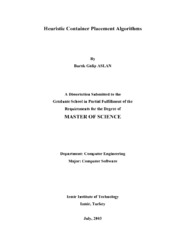Please use this identifier to cite or link to this item:
https://hdl.handle.net/11147/3640Full metadata record
| DC Field | Value | Language |
|---|---|---|
| dc.contributor.advisor | Püskülcü, Halis | en |
| dc.contributor.author | Aslan, Burak Galip | - |
| dc.date.accessioned | 2014-07-22T13:52:00Z | - |
| dc.date.available | 2014-07-22T13:52:00Z | - |
| dc.date.issued | 2003 | en |
| dc.identifier.uri | http://hdl.handle.net/11147/3640 | - |
| dc.description | Thesis (Master)--Izmir Institute of Technology, Computer Engineering, Izmir, 2003 | en |
| dc.description | Includes bibliographical references (leaves: 56-58) | en |
| dc.description | Text in English; Abstract: Turkish and English | en |
| dc.description | viii, 72 leaves | en |
| dc.description.abstract | With the growth of transportation over sea; defining transportation processes in a better way and finding ways to make transportation processes more effective have become one of the most important research areas of today. Especially in the last quartet of the previous decade, the computers had become much powerful tools with their impressive amount of data processing cababilites. It was imminent that computers had begun taking serious roles in the system development studies. As a result; constructing models for the processes in container terminals and processing the data with the computers create opportunities for the automation of various processes in container terminals. The final step of these studies is the full automation of terminal activities with software packages that combine various functions focused on various processes in a single system.This study is about a project that had been made for a container terminal owned by a special company. During this study; there had been discussions with experts about the subject, and container handling processes in the terminal had been analyzed in order to define the main structure of the yard management software to be created.This study focuses on the container handling activities over the yard space so as to create a basis for a computer system that will take part in the decisions during the container operations. Object oriented analysis and design methods are used for the definition of the system that will help the decisions in the yard operations. The optimization methodology that will be the core of the container placement decisions is based on using different placement patterns and placement algorithms for different conditions. These placement patterns and algorithms are constructed due to the container handling machinery that was being used in the terminal that this study has been made for. | en |
| dc.language.iso | en | en_US |
| dc.publisher | Izmir Institute of Technology | en |
| dc.rights | info:eu-repo/semantics/openAccess | en_US |
| dc.subject.lcc | QA76.9.A43 A85 2003 | en |
| dc.subject.lcsh | Algorithms | en |
| dc.subject.lcsh | Computer algorithms | en |
| dc.subject.lcsh | Container terminal | en |
| dc.subject.lcsh | Electronic data processing | en |
| dc.subject.lcsh | Heuristiq programming | en |
| dc.title | Heuristic container placement algorithms | en_US |
| dc.type | Master Thesis | en_US |
| dc.institutionauthor | Aslan, Burak Galip | - |
| dc.department | Thesis (Master)--İzmir Institute of Technology, Computer Engineering | en_US |
| dc.relation.publicationcategory | Tez | en_US |
| item.grantfulltext | open | - |
| item.openairetype | Master Thesis | - |
| item.fulltext | With Fulltext | - |
| item.cerifentitytype | Publications | - |
| item.openairecristype | http://purl.org/coar/resource_type/c_18cf | - |
| item.languageiso639-1 | en | - |
| crisitem.author.dept | 03.04. Department of Computer Engineering | - |
| Appears in Collections: | Master Degree / Yüksek Lisans Tezleri | |
Files in This Item:
| File | Description | Size | Format | |
|---|---|---|---|---|
| T000268.pdf | MasterThesis | 3.16 MB | Adobe PDF |  View/Open |
CORE Recommender
Page view(s)
172
checked on Jul 15, 2024
Download(s)
86
checked on Jul 15, 2024
Google ScholarTM
Check
Items in GCRIS Repository are protected by copyright, with all rights reserved, unless otherwise indicated.